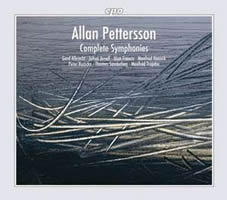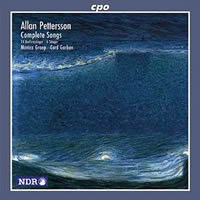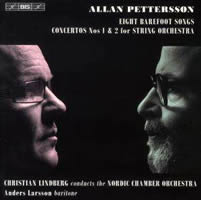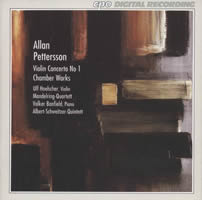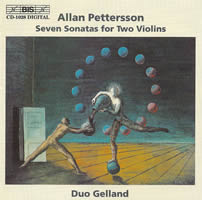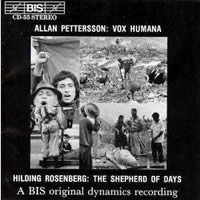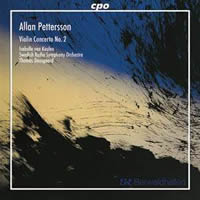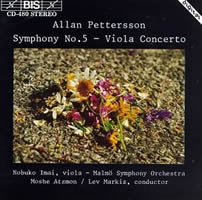Allan Pettersson’s Greatest Hits
|
Grant Chu Covell [May 2009.] “The music forming my work is my own life, its blessings, its curses: in order to rediscover the song once sung by the soul.”— Allan Pettersson I hadn’t intended a lengthy Pettersson soak, but having plowed through the symphonies, it seemed necessary to revisit some of the Swede’s less grueling music. For some, it may simply be enough to know that there’s a Scandinavian composer straddling Romantic and modern styles who thought his work was being suppressed and who wrote long and depressive symphonies, often deliberately ugly, despite fleeting moments of beauty. Pettersson’s less harsh non-symphonic output includes songs, concertos and a cantata, and reflects a fluency with 20th-century trends. The symphonies are best broadcast over PA systems to clear parking fields of carjackers and skateboarders, likewise to repel callers on hold. I remember stepping into a CD store just before closing (an HMV in Ottawa — I got the Sony recording of Stockhausen’s Klavierstücke and Mikrophonie I & II) as they were playing the Fourteenth. They were more surprised that I recognized the composer than I was by what I heard. Gustav Allan Pettersson (1911-80) was not a happy soul. Cpo appears to have cornered the market on Pettersson recordings, wherein one reads this perhaps too-dramatic overview:
We do know that as a youth Pettersson bought a violin with money made from selling postcards, contrary to paternal edicts. He taught himself, eventually demonstrating enough skill to be admitted to the Stockholm Royal Conservatory in 1930. A disagreement with his teacher, Julius Ruthström, a Joachim disciple, led to a new teacher and instrument, the viola. He held a seat in the Stockholm Concert Society Orchestra — eventually the Stockholm Philharmonic — from 1939 to 1952. When composition dominated his interests, he took a leave to study with Leibowitz and Honegger in Paris. Like a harangue that won’t stop, Pettersson’s symphonies can grow wearing. While it’s easy to identify Mahler as the most obvious influence, Pettersson’s angst and presumption of victimization are significantly vaster. Stylistically, we hear a few tricks from Shostakovich’s toolbox, infrequent chorale motions suggesting J.S. Bach, and occasional march and minor-mode polka gestures. Clotted tonality, tending towards lugubrious, multiple dissonant lines, is everywhere.
“Complete Symphonies.” Allan PETTERSSON: Symphonies Nos. 2-16; Symphonic Movement. Peter RUZICKA: “…das Gesegnete, das Verfluchte…”* (1991). John-Edward Kelly16 (a-sax), BBC Scottish Symphony Orchestra2, 13, SM, Deutsches Symphonie-Orchester Berlin*, 6, 8, 9, 14, 15, Rundfunk-Sinfonieorchester (RSO) Saarbrücken3, 4, 5, 16, Radio-Philharmonie Hannover des NDR10, 11, Philharmonisches Staatsorchester Hamburg7, Swedish Radio Choir12, Eric Ericson Chamber Choir12, Swedish Radio Symphony Orchestra12, Alun Francis2, 3, 4, 5, 9, 10, 11, 13, 16, SM, Manfred Trojahn6, Thomas Sanderling8, Johan Arnell14, Peter Ruzicka*, 15, Gerd Albrecht7, Manfred Honeck12 (conds). cpo 777 247-2 (12 CDs also available separately; recordings made between 1984 and 2004) (http://www.cpo.de/). Distributed in the US by Naxos (http://www.naxos.com/). At this point, you probably know whether you’re up for Pettersson’s symphonies. The uninitiated should start with the Seventh (1966-67), Pettersson’s first big international success due to Antal Doráti’s efforts. With recognizable motives, dark hues reminiscent of Wagner’s Siegfried, broad pacing and a ravishing sunlit oasis, the Seventh ably demonstrates the composer’s usages. A First was never completed. The Second (1952-53), stretching to 46:23, lumbers like supremely crabby Mahler. The Third (1954-55) and Fourth (1958-59) are under 40 minutes each. Most Pettersson symphonies are single movements. The Third tries a four-movement plan. From the Fifth (1960-62) onward, Pettersson’s argument grows convoluted and abstract, slipping rather manically between extremes. After the Fifth with its brief bright patches, Pettersson’s waning health prevented him from writing legibly. In the hour-long Sixth (1963-66), crests and troughs are more apparent, with repeated gestures aiding digestion. Distinctive motives make the Seventh comprehensible. The two-part funereal Eighth (1968-69) trades aggressive dissonance for simpler minor-mode skulking. Written on the eve of a hospital admittance to remedy a life-threatening kidney ailment, the anxiously driven Ninth (1970) busies itself for almost 70 minutes. Program notes allude to serial principles. In the Ninth, despite the many lines and rapid chromatic figures, Pettersson’s orchestral writing becomes more lucid. The concluding cadence is completely unexpected. The later symphonies are noisy, knotted mammoths. They must be wearying to rehearse and perform. Cpo’s series pairs the Tenth (1970-72) and Eleventh (1973), likely conceived together. Both single-movements run their course in less than 30 minutes. Pettersson wrote the fulminating Tenth, reportedly on gauze bandages, during the nine-month hospital stay. In contrast with No. 10’s agitato, No. 11 is an Adagio with an unexpected string-dominant coda that suggests a battle-weary, accelerating Pärt. The 1973 Symphonic Movement stops as if time ran out. The 1974 Twelfth, Pettersson’s 53:05 choral symphony, was covered here. No. 13 (1976) is especially bleak, its 67 minutes made all the more arduous by the BBC Scottish Symphony Orchestra’s seeming incomprehension. The 47-minute Fourteenth and 38:18 Fifteenth (both 1978) are slightly less miserable. Cancer and polyarthritis rendered Pettersson essentially immobile. For much of the 1970s he was confined to a noisy, fourth-floor apartment. He wrote No. 14 after he had been provided state living quarters. Despite his new home’s garden, the symphonies didn’t get appreciably sunnier. The last-completed symphony, the Sixteenth (1979), includes a concertante part for alto saxophone. Frederik L. Hemke requested that Pettersson write something for saxophone; this symphony materialized some time later. Even though the sax busies constantly over the churning orchestra, at 24:23 it’s not really a concerto. One rarely has the sense that the orchestra accompanies the alto sax, which appears as but one among many lines, albeit more prominent. The performance includes Kelly’s alterations to the solo part to compensate for Pettersson’s lack of practical experience with the instrument. Composer/conductor Ruzicka subtitled his four orchestral sketches, “…das Gesegnete, das Verfluchte…” (1991), a Pettersson requiem. Into “…its blessings, its curses…” he interwove sketches of the incomplete Seventeenth and other quotations. Of course, no one can do Pettersson quite like Pettersson. While Ruzicka’s 13:44 homage isn’t as blistering as the music of its dedicatee, its dark muscularity makes a fitting coda to the cycle. * * * Not everything Pettersson wrote was harsh and long. This is definitely true of the early, mature compositions which predate the symphonies. Several late-period concertos and a cantata also reveal a relaxed style. Cpo (http://www.cpo.de/) is distributed in the US by Naxos (http://www.naxos.com/); BIS (http://www.bis.se/) is distributed in the US by Qualiton (http://www.qualiton.com/).
The texts to 24 Barefoot Songs (1943-45) are Pettersson’s. In a confident late-Romantic style continuing the tradition starting with Schubert and perpetuated by Mahler and Wolf, these nicely contoured tonal songs suggest a gifted miniaturist. The sobering texts are most likely biographical. Listeners unfamiliar with Swedish will be unaware that the songs address simple pleasures, poverty, entreaties to God, and death. Six older songs from 1935 are actually more adventurous. On cpo 999 499-2, mezzo soprano Monica Groop and pianist Cord Garben perform with simple elegance. After his success premiering Pettersson’s Seventh, Antal Doráti arranged several of the Barfotasånger for voice and orchestra. They can be heard with baritone Anders Larsson and the Nordic Chamber Orchestra under Christian Lindberg on BIS-CD-1690. In their orchestral garb, the soft tonality glows like Mahler’s Des Knaben Wunderhorn or orchestral arrangements of Schubert lieder. There are subtle wrinkles in phrases that suggest Ives. On this disc, the eight orchestrated Barefoot Songs precede energetic readings of Pettersson’s first two string orchestra concertos.
The 1949 First Violin Concerto, actually a Concerto for Violin and String Quartet, blends folk music and echoes of Bartók and early Schoenberg. Pettersson had been studying with Otto Olsson and Karl-Birger Blomdahl (Blomdahl’s space opera Aniara was less than a decade away). Given the music’s rugged individualism and stern tone, I would have guessed Wolpe or Schnabel. Insistent cadences suggest later habits. The last movement employs quarter-tones that appear nowhere else in Pettersson’s work. Far removed from the Swedish mainstream, the Concerto was poorly received at its March 10, 1951 premiere. One reviewer branded it a “sawmill.” Despite the unusual scoring, the work is not without its attractions. On cpo 999 169-2, where soloist Ulf Hoelscher joins with the Mandelring Quartet, the 30-minute concerto is padded with a 1945 piano Lamento, a Fugue in E for oboe, clarinet and bassoon, and two student works, Four Improvisations for string trio and a viola Fantasy, both from 1936. On BIS-CD-1028, the solo-piano Lamento and a collection of early violin / piano works, Two Elegies (1934), Romanza (1942) and Andante espressivo (1938), fill out another release with a significant early opus, the Seven Sonatas for Two Violins (1951). Perpetually inventive and technically demanding, they’re neither slight nor instructional like Bartók or Berio’s duos. The music is densely packed with expressive melodies, folksong elements and much double-stopping and intertwined voices. Of unequal lengths, some are single movements (1, 3, 4, 5 and 7). The Sixth Sonata sparkles with pizzicato glissandos. The Duo Gelland (Cecilia and Martin) cavort like mountain goats throughout this challenging and rewarding music.
When Pettersson turned to large-scale forms, he alternated between symphonies and string-orchestra concertos. The Concerto for String Orchestra No. 1 (1949-50) predates the incomplete First Symphony. Concerto No. 2 (1956) and Concerto No. 3 (1956-57) were both written between the Third and Fourth symphonies. The first two concertos are each less than half an hour, but the third doubles the time scale. These are strident three-movement pieces. Imagine Bartók in a nasty frame of mind. At its 1952 premiere, Concerto No. 1 met with praise and bafflement. For a German performance the next year, Scherchen programmed the concerto alongside Webern and Stockhausen. Despite its leathery dissonance, the work did not suggest that Pettersson was looking ahead; as a consequence, his achievements were sidelined. In contrast to the early symphonies (the Second through the Fifth), the string-orchestra concertos project a greater confidence. They require determined, passionate performers. On cpo 999 225-2 (2CDs) the Deutsche Kammerakademie under Johannes Goritzki digs in wholeheartedly. Sung texts reappear in two 1974 works, a chorus laboring throughout the Twelfth and the cantata Vox Humana. Incongruous among his late works, Vox balances soloists, chorus and string orchestra. Defying expectations, late in life Pettersson wrote close to tonal, tuneful, expressive melodies in predominantly minor mode. Hardly festive, though less oppressive than the Twelfth, Vox Humana calls for gray, rainy skies. Shostakovich’s Fourteenth (1969) would be a close cousin. BIS-CD-55 pairs the cantata with Hilding Rosenberg’s 1963 Dagdrivaren.
Premiered by Ida Haendel, whose own recording appears to be O/P, Pettersson composed his Second Violin Concerto (1977-78) between the Thirteenth and Fourteenth symphonies. Occupying nearly an hour, it’s a roller-coaster ride, narrowly less despondent than the symphonies, though equally probing. Pettersson maintains a grim demeanor long after other composers would have shifted to variety or repose. I heard slight neo-classical touches recalling Stravinsky’s Violin Concerto, gestures wholly absent from the symphonies. Compared to the Sixteenth with its alto-saxophone part, the Second Violin Concerto straddles a wider emotional range. The orchestra does accompany the soloist, especially in the work’s more relaxed final pages which become sublimely beautiful. These ultimate oases make the churn worthwhile. An insecure soloist would likely drown. Isabelle van Keulen remains afloat on cpo 777 199-2 with the Swedish Radio Symphony Orchestra under Thomas Dausgaard. Sorting through Pettersson’s manuscripts after his death, Peter Ruzicka discovered a predictably gloomy and insistent Viola Concerto (1979) about which even Pettersson’s widow knew nothing. Where the soloist could rise above the Second Violin Concerto’s mass, likewise the saxophone in the Sixteenth Symphony, Pettersson actually limits the orchestral commotion, allowing the soloist to take center stage. There’s a moment (at 23:29 on BIS-CD-480 with Nobuko Imai, viola, and the Malmö Symphony Orchestra led by Lev Markiz) where the fading orchestra permits us to hear a few quick gestures, as if to spark a cadenza. The work doesn’t offer relief as does the Second Violin Concerto. Why Pettersson kept its existence to himself is unclear, since there’s little of an overtly valedictory quality in evidence. (The CD pairs the Viola Concerto with a smooth rendition of the Fifth, by Moshe Atzmon and the Malmö Symphony Orchestra.) Quite possibly there are layers that remain to be excavated.
[More Grant Chu Covell, Mostly Symphonies]
[More
Pettersson]
[Previous Article:
Abbey Simon in Concert]
[Next Article:
Musique de Chambre de Musique (l’Amérique et plus nord)]
|
